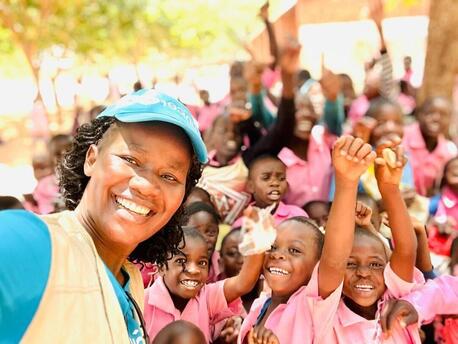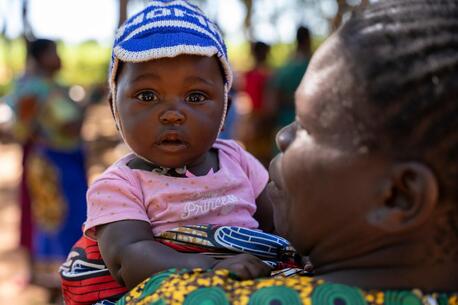
UNICEF USA's Bridge Fund & UNICEF Create Systemic, Sustainable Change
Through social impact investment, we work together to help make progress towards the UN's Sustainable Development Goals 2030.
What Are the U.N. Sustainable Development Goals?
In 2015, 193 countries and the United Nations established 17 concrete Sustainable Development Goals (SDGs) to create a better world by 2030. Among many other key objectives, the SDGs involve ending poverty and malnutrition, fighting inequality, enhancing health and well-being, and increasing access to safe water and quality education in every participating country.
The SDGs involve ending poverty and malnutrition, fighting inequality, enhancing health and well-being, and increasing access to safe water and quality education in every participating country.
Each SDG includes multiple targets or objectives, and there are a total of 169 targets for the SDGs. Each target incorporates specific indicators used to evaluate progress towards a particular goal at the local, national, regional, and global level. For example, SDG 1, which calls for “Zero Hunger,” has eight targets, including one that involves ending all forms of malnutrition. That target, in turn, involves several specific indicators, including one that measures the prevalence of “stunting” — a medical condition, caused by chronic malnutrition, that impairs normal development as defined by the World Health Organizations’s Child Growth Standards — among children under age five.

UNICEF's Role in SDG Progress for Children
As UNICEF’s new Executive Director, Henrietta H. Fore, remarked at the opening of the UNICEF Executive Board’s February 2018 meeting: “As a global community, we must ask ourselves: What will [children’s] futures look like? Will they be healthy and nourished? Will they have the opportunity to go to school and learn? Will they gain the skills and tools they need to participate in their local economy as citizens of their countries? Will they be protected?”
As a global community, we must ask ourselves: What will children’s futures look like?
The answers to Fore’s questions will depend on how well the world implements the SDGs for children. That’s why UNICEF, which played a key role in the multi-year, global consultation that led to the establishment of the SDGs, is the official custodian or co-custodian of 17 SDG indicators. Some of these indicators include skilled attendance at birth, fully immunized children, under-five child mortality, early childhood development, child labor, and safely managed water. As an indicator custodian, UNICEF supports countries in generating, analyzing and using data about these indicators to support SDG progress for their entire populations.
UNICEF’s SDG leadership also includes developing international standards for SDG measurement, helping to compile and verify national data, and maintaining global databases. Data custodianship is far more than purely technical, however. It involves funding, too. As a Skoll Foundation-supported 2017 report noted, funders must “look at how to better align the metrics they look for with existing systems, such as the Sustainable Development Goals” if they hope to collaborate more effectively with NGOs and social entrepreneurs and scale big solutions to meet the SDGs by 2030.
Beyond data, UNICEF’s SDG role for children involves: 1) supporting country-level service delivery, policy and budgeting; 2) global and national SDG accountability with governments and civil society; and 3) creative solutions for delivering results for children in the most timely, efficient, and effective way.
UNICEF's Strategic Plan and SDGs for Children

Indeed, UNICEF — with its equity commitment to reaching the most vulnerable — has woven the SDGs into its new 2018-2021 strategic plan. For example, UNICEF’s health-related strategic goal to ensure that “every child survives and thrives” also helps to move the needle towards fulfilling SDG 3, which involves “good health and well-being” and requires that the world “ensures healthy lives and promotes the well-being of all at all ages.” UNICEF’s educational programs, designed to guarantee that “every child learns,” are also geared towards fulfilling SDG 4, which involves “quality education” and seeks to “ensure inclusive and equitable quality education and promote lifelong learning opportunities for all.”

How Philanthropy and Private Capital Can Collaborate to Fund SDG Progress
One crucial goal, SDG 17, contains a call-to-action for governments, business, civil society, and the philanthropic sector. They must all collaborate to build the better future the SDGs envision. That’s why UNICEF seeks to mobilize these same actors to partner in new ways — from innovative finance to donated technical expertise — in order to help reach SDG goals for children.
One crucial goal, SDG 17, contains a call-to-action for governments, business, civil society, and the philanthropic sector.
Axel Weber, UBS Chairman, speaking about marshaling private sector support for the SDGs, noted: “The UN Sustainable Development Goals define the world’s aspirations in addressing social and environmental issues. The 17th SDG — strengthening implementation and revitalizing the global partnership for sustainable development — will be critical to meeting the SDGs’ 2030 deadline.”
UNICEF USA's Innovative Leadership in Social Impact Investing for Children
Given its investment mission to leverage private sector financing for UNICEF, the UNICEF USA Bridge Fund has helped meet UNICEF’s financing needs since the Fund’s founding in 2011. The Bridge Fund also recognizes the importance of SDG 17 and its call for new sources of SDG funding. In fact, to date, the Bridge Fund has accelerated $210 million from private sector sources for UNICEF’s programs, including health, education and water, sanitation and hygiene, helping to contribute to UNICEF’s SDG initiatives.
In fact, to date, the Bridge Fund has accelerated $210 million from private sector sources for UNICEF’s programs, including health, education and water, sanitation and hygiene, helping to contribute to the SDGs.
For example, by bridging gaps between the timing of funder commitments and programmatic needs on the ground, the Bridge Fund has helped accelerate vaccination in the global fight against polio. The Bridge Fund has also helped speed equitable access to education for children harmed by the Syrian refugee crisis and helped accelerate safe water access for children and adolescents in Syria, Jordan and Brazil.

Bashar, 11, a Syrian child refugee living in the Za’atari Refugee camp in Jordan, uses a laptop in an educational program like those supported by the UNICEF USA Bridge Fund. ©UNICEF/UN051294/Herwig
As UNICEF USA looks to support UNICEF’s programming and its SDG work in the future, there are new impact investing opportunities to explore. “The Bridge Fund is proud of the investment dollars we have attracted in the past eight years to support UNICEF’s work,” explains Edward G. Lloyd, UNICEF USA’s Chief Operating Officer and Chief Financial Officer. “As we seek to partner with UNICEF to create innovative impact investing solutions to help further UNICEF’s SDG initiatives, we hope to work with corporations, foundations, investors and donor collaboratives to put children first around the world.”
The UNICEF USA Bridge Fund hopes to work with corporations, foundations, investors and donor collaboratives on new solutions to putting children first around the world.
How You Can Learn More and Take Action
Are you, or the organization you work for, social impact investors?
Or, are you a donor who cares about making systemic, sustainable progress for children around the world?
Top Photo: Students at a girls' primary school in Freetown, Sierra Leone’s capital, pictured after their lesson on the Sustainable Development Goals 2030. ©UNICEF/2015/Kassaye
HOW TO HELP
There are many ways to make a difference
War, famine, poverty, natural disasters — threats to the world's children keep coming. But UNICEF won't stop working to keep children healthy and safe.
UNICEF works in over 190 countries and territories — more places than any other children's organization. UNICEF has the world's largest humanitarian warehouse and, when disaster strikes, can get supplies almost anywhere within 72 hours. Constantly innovating, always advocating for a better world for children, UNICEF works to ensure that every child can grow up healthy, educated, protected and respected.
Would you like to help give all children the opportunity to reach their full potential? There are many ways to get involved.





